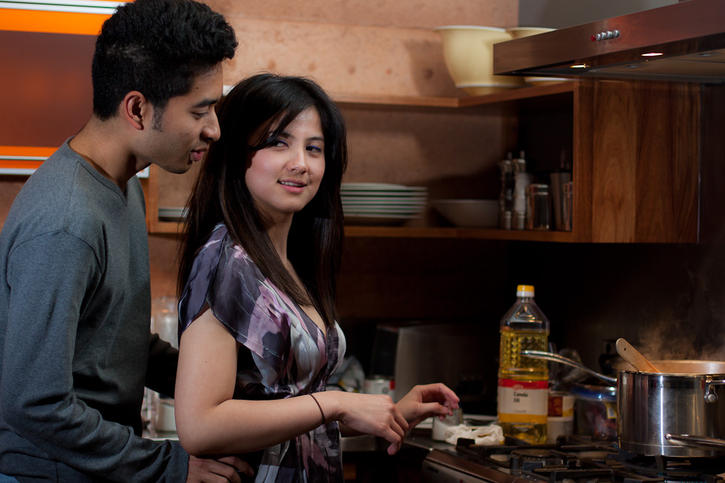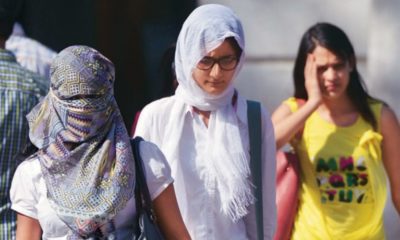Feature
Indian women want men to actively help in household chores during festivals

New Delhi: Number of majority of Indian women want men to actively help in household chores during festivals, reveals a survey.
According to a matchmaking website www.shaadi.com service, conducted a survey to understand what Indian men and women think about roles in marriage, especially during festivals.

When women were asked ‘During festivals, do you think men and women have equal responsibilities?’, 66 per cent said ‘No’ and 34 per cent said ‘Yes’.
When men were asked the same question, 75 per cent said ‘Yes’ and 25 per cent said ‘No’.
The data suggests a clear disparity in the point of view of men and women when it comes to sharing responsibilities.
However, the men are no longer expecting women to handle all responsibilities, especially during festivals.
Indian women want equal contribution from men in household during festivals:
When asked, ‘Do you think it’s a woman’s responsibility to do all the household activities?’, 100 per cent of the users (both men and women) said ‘NO’.
As a follow-up, they were also asked, ‘Do you think men and women should share equal responsibilities in household activities?’, 100 per cent of the users (both men and women) said ‘Yes’.
That said, it is believed that women are more involved in festivals, and when asked ‘Do you think women are more enthusiastic during festivals?’, 47 per cent said ‘Yes’, 42 per cent said ‘Maybe’ and 11 per cent said ‘No’.

The survey also revealed that women would like an equal contribution, and when asked ‘How would you like the men to contribute?’, 83 per cent said ‘Actively helping in the household chores’, 17 per cent said ‘Cleaning the house’ and zero per cent chose ‘Cooking for family and guests’.
This online survey received over 7300 responses from Indians (men and women; single and married) aged between 24 and 40 years.
“We, at Shaadi.com, believe that marriage is an equal platform and it is equality in marriage that leads to a happy marital life. It is very encouraging to see that this thought resonates with the mindset of today’s youth,” Gourav Rakshit, Chief Executive Officer, Shaadi.com, said in a statement.
Entertainment
Meghalaya Reserves Legalized Gambling and Sports Betting for Tourists

The State Scores Extra High on Gaming-Friendly Industry Index
Meghalaya scored 92.85 out of 100 possible points in a Gaming Industry Index and proved to be India’s most gaming-friendly state following its recent profound legislation changes over the field allowing land-based and online gaming, including games of chance, under a licensing regime.
The index by the UK India Business Council (UKIBC) uses a scale of 0 to 100 to measure the level of legalisation on gambling and betting achieved by a state based on the scores over a set of seven different games – lottery, horse racing, betting on sports, poker, rummy, casino and fantasy sports
Starting from February last year, Meghalaya became the third state in India’s northeast to legalise gambling and betting after Sikkim and Nagaland. After consultations with the UKIBC, the state proceeded with the adoption of the Meghalaya Regulation of Gaming Act, 2021 and the nullification of the Meghalaya Prevention of Gambling Act, 1970. Subsequently in December, the Meghalaya Regulation of Gaming Rules, 2021 were notified and came into force.
All for the Tourists
The move to legalise and license various forms of offline and online betting and gambling in Meghalaya is aimed at boosting tourism and creating jobs, and altogether raising taxation revenues for the northeastern state. At the same time, the opportunities to bet and gamble legally will be reserved only for tourists and visitors.
“We came out with a Gaming Act and subsequently framed the Regulation of Gaming Rules, 2021. The government will accordingly issue licenses to operate games of skill and chance, both online and offline,” said James P. K. Sangma, Meghalaya State Law and Taxation Minister speaking in the capital city of Shillong. “But the legalized gambling and gaming will only be for tourists and not residents of Meghalaya,” he continued.
To be allowed to play, tourists and people visiting the state for work or business purposes will have to prove their non-resident status by presenting appropriate documents, in a process similar to a bank KYC (Know Your Customer) procedure.
Meghalaya Reaches Out to a Vast Market
With 140 millions of people in India estimated to bet regularly on sports, and a total of 370 million desi bettors around prominent sporting events, as per data from one of the latest reports by Esse N Videri, Meghalaya is set to reach out and take a piece of a vast market.
Estimates on the financial value of India’s sports betting market, combined across all types of offline channels and online sports and cricket predictions and betting platforms, speak about amounts between $130 and $150 billion (roughly between ₹9.7 and ₹11.5 lakh crore).
Andhra Pradesh, Telangana and Delhi are shown to deliver the highest number of bettors and Meghalaya can count on substantial tourists flow from their betting circles. The sports betting communities of Karnataka, Maharashtra, Uttar Pradesh and Haryana are also not to be underestimated.
Among the sports, cricket is most popular, registering 68 percent of the total bet count analyzed by Esse N Videri. Football takes second position with 11 percent of the bets, followed by betting on FIFA at 7 percent and on eCricket at 5 percent. The last position in the Top 5 of popular sports for betting in India is taken by tennis with 3 percent of the bet count.
Local Citizens will Still have Their Teer Betting
Meghalaya residents will still be permitted to participate in teer betting over arrow-shooting results. Teer is a traditional method of gambling, somewhat similar to a lottery draw, and held under the rules of the Meghalaya Regulation of the Game of Arrow Shooting and the Sale of Teer Tickets Act, 2018.
Teer includes bettors wagering on the number of arrows that reach the target which is placed about 50 meters away from a team of 20 archers positioned in a semicircle.
The archers shoot volleys of arrows at the target for ten minutes, and players place their bets choosing a number between 0 and 99 trying to guess the last two digits of the number of arrows that successfully pierce the target.
If, for example, the number of hits is 256, anyone who has bet on 56 wins an amount eight times bigger than their wager.























